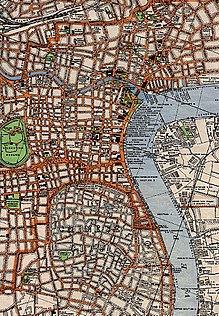

|
|
→Fortifications: ce
|
||
| Line 5: | Line 5: | ||
An original city wall dating back to the 11th century surrounded the ancient city of Shanghai.<ref name="Simon395"/> The [[city wall]], parts of which remain to this day, was built in 1554, in order to protect the town from raids by [[Wokou|Japanese pirates]]. It measured 10 metres high and 5 kilometres in circumference.<ref name="Perry15">''Shanghai on Strike: The Politics of Chinese Labor'' by Elizabeth Perry p.15 [http://books.google.com/books?id=D0oAqaajaR0C&pg=PA15]</ref> |
An original city wall dating back to the 11th century surrounded the ancient city of Shanghai.<ref name="Simon395"/> The [[city wall]], parts of which remain to this day, was built in 1554, in order to protect the town from raids by [[Wokou|Japanese pirates]]. It measured 10 metres high and 5 kilometres in circumference.<ref name="Perry15">''Shanghai on Strike: The Politics of Chinese Labor'' by Elizabeth Perry p.15 [http://books.google.com/books?id=D0oAqaajaR0C&pg=PA15]</ref> |
||
There were originally 6 gates built into the structure: |
There were originally 6 gates built into the structure, and 3 water gates: |
||
{| class="wikitable" align="left" style="margin-left: 1em;" style="font-size: 80%;" |
{| class="wikitable" align="left" style="margin-left: 1em;" style="font-size: 80%;" |
||

The Old City of Shanghai (上海古城, Shànghăi Gùchéng) refers to the most ancient area of Shanghai. It is circular in shape even today, and used to be surrounded by a defensive wall. Today, the walls have been replaced by broad circular avenues, the Renmin Lu to the North and Zhonghua Lu to the South.
An original city wall dating back to the 11th century surrounded the ancient city of Shanghai.[1] The city wall, parts of which remain to this day, was built in 1554, in order to protect the town from raids by Japanese pirates. It measured 10 metres high and 5 kilometres in circumference.[2]
There were originally 6 gates built into the structure, and 3 water gates:
| Gates of the Old City of Shanghai | |||
| Old City map | Gate | Chinese name | Image |
 Original map of the Old City (circa 1860)  Gates in red, Water gates in blue. | |||
| Small Eastern Gate | 小東門 also: 宝帯門 "Gate of the Diamond Belt" |

| |
| Small Eastern Water Gate | 小東門水門 also: 小東門処跨方浜 |

| |
| Great Eastern Gate | 大東門 also: 朝宗門 "Gate of Dynastic Ancestors" |
||
| Eastern Water Gate | 東門水門 | 
| |
| Small Southern Gate | 小南門 also: 朝陽門 "Gate of the Rising Sun" |
||
| Great Southern Gate | 大南門 also: 跨龍門 "Gate of the Leaping Dragon" |
||
| Western Water Gate | 西門水門 also: 西門跨兆家浜 |
||
| Old Western Gate | Laoximen 老西門 also: 儀鳳門 "Gate of the Virtuous Phoenix" |

| |
| Old Northern Gate | 老北門 also: 晏海門 "Gate of the Peaceful Sea" |

| |
| New Northern Gate (built 1860) |
新北門 also: 障川門 |

| |
A protective moat surrounded the wall, 20 meters large and 6 meters deep, which was accessed though 3 "Water Gates" (two in the east, one in the west).[3]
In 1860 a new gate was created, the "New Northern Gate" (新北門or障川門). In 1909, three new gates were pierced:
The Old City remained in place, while new urban areas were being developped on the outskirt though Concessions after the Opium War in 1842.[2] The Old City remained, and was known as the "Chinese City", while the Concessions were named "Northern City" (北城), where only foreigners could live.[1] During the period of Concessions, numerous Chinese lived in packed conditions in the Old City, which functioned as a sort of ghetto.[1]
During the Taiping Rebellion in 1853, the Old City was captured by the forces of the Small Swords Society. The Governor of Shanghai Wu Jianzhang fled to the British Concession and had to transfer control of trade to the foreigners in exchange for help in retaking the city.[4] Also, after 1854, the Chinese were allowed to live outside of the Old City and could settle in the Foreign Concessions.
The Old City walls were dismantled in 1912 however by the Chinese revolutionary General Chen Qimei, then new Governor of Shanghai.[1][5] Today only a very small portion remains, which has been transformed into a museum, the Dàjìng Gé Pavillon (上海古城墙和大境阁).

Today the Old City contains some ancient but renovated features, such as the Yuyuan Garden complex, and the City God Temple. [6] Its circular shape is now imprinted by the surrounded large streets which occupy the space of the former walls, the Renmin Lu to the North and Zhonghua Lu to the South.[1] The Old City has also been cut in the middle North to South by Henan Lu.[1] The Old City is a combination of ancient winding streets, with some modern high-rise buildings progressively encroaching on the older areas.[1]
|
| |||||||||||||||||||
|---|---|---|---|---|---|---|---|---|---|---|---|---|---|---|---|---|---|---|---|
| |||||||||||||||||||
| Administrative divisions |
| ||||||||||||||||||
| Culture and demographics |
| ||||||||||||||||||
| Tourist attractions |
| ||||||||||||||||||
| Places of worship |
| ||||||||||||||||||
| Skyscrapers |
| ||||||||||||||||||
| Sports venues |
| ||||||||||||||||||
| Sports teams |
| ||||||||||||||||||
| Transport |
| ||||||||||||||||||
| Universities |
| ||||||||||||||||||
| |||||||||||||||||||
31°13′30″N 121°29′06″E / 31.225°N 121.485°E / 31.225; 121.485 (Old City of Shanghai)